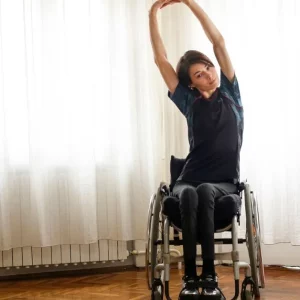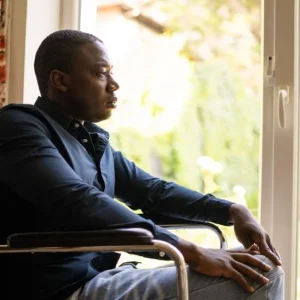Bradycardia is a medical condition that occurs when your heart rate consistently falls below 60 beats a minute.
To put this into perspective, anywhere between 60-100 beats per minute is considered to be a normal heart rate range.
While a resting heart rate below 60 in athletes is often an indicator of cardiovascular health, it can also be a serious health condition that requires medical attention. Unfortunately, bradycardia is very common after spinal cord injury, especially in higher-level (T6 and up) injuries.
To help you understand the link between spinal cord injury and heart rate, this article will go over the causes, symptoms, and management for bradycardia after SCI.
Spinal Cord Injury and Bradycardia
Your autonomic nervous system controls many body functions that do not require have conscious thought, like heart rate, temperature, digestion, and blood pressure. The autonomic nervous system is further broken down into two parts: the sympathetic and parasympathetic nervous systems.
The sympathetic nervous system controls your ‘fight or flight’ response, which is activated in times of stress. As a result, your heart rate and blood pressure increase.
In contrast, the parasympathetic nervous system regulates your ‘rest and digest’ response. In this case, your heart rate and blood vessels relax to allow your body to return to a resting and relaxed state.
This information is important to grasp, because the nerves that increase your heart rate, via the sympathetic nervous system, are located around the T1-T5 segments of the spinal cord. Therefore, spinal cord injuries that include these segments can potentially cause problems with your heart rate regulation.
Interestingly, parasympathetic nerves are unaffected by spinal cord injury. Because of this, you may experience an imbalance with high parasympathetic input that can result in bradycardia.
Signs and Symptoms of Bradycardia After Spinal Cord Injury

Signs and symptoms of bradycardia include:
- Fatigue
- Weakness
- Dizziness
- Confusion
- Fainting
- Shortness of breath
Oxygen-rich blood and other nutrients that are essential to fuel cellular activity and keep our bodies running. Therefore, issues can occur because the heart is unable to pump enough blood throughout the body.
Ultimately, without a sufficient supply of blood, our bodies start to feel weak and cannot function optimally.
Neurogenic Shock
When parasympathetic tone is left unchecked after spinal cord injury, neurogenic shock can result. During this process, the heart rate slows as the blood vessels get bigger (also known as vasodilation). This causes blood to pool in the arms and legs, instead of returning to the heart.
It’s important for you to realize that neurogenic shock is a serious medical condition. If left untreated, it can cause your major organ systems to fail due to poor circulation.
Autonomic Dysreflexia

Bradycardia can also happen during autonomic dysreflexia.
Autonomic dysreflexia is a medical condition that occurs when the body overreacts when stimulated below your level of injury.
After a spinal cord injury, you may lose sensation below your level of injury. Think of autonomic dysreflexia as your body’s way of letting you know that something isn’t right.
Common triggers of autonomic dysfunction include:
- Tight clothes
- Extreme temperatures
- Full bladder
- Skin irritations
When stimulated, your sympathetic reflexes will react and tighten blood vessels. As a result, the baroreceptors (nerves that relay information about blood pressure to the brain) tell the brain to send out signals to relax the blood vessels.
However, these brain signals cannot get past the site of injury and only affects the body above your level of injury. This leads to hypertension (high blood pressure) below your level of injury, vasodilation above your level of injury, and bradycardia.
This imbalance can cause you to experience headaches, feelings of anxiety, and warmer temperatures above your level of injury.
Managing Bradycardia After Spinal Cord Injury
Treatments for bradycardia focus on restoring a normal heart rate.
Generally, atropine will be prescribed to reduce the influence of the vagus nerve, which causes the heart rate to rise.
Other treatments for bradycardia include the use of IV fluids to increase volume in the blood vessels or the use of vasopressors, like norepinephrine and dopamine.
Vasopressors make the blood vessels smaller in an attempt to increase heart rate and blood pressure. This prevents blood from pooling in the arms and legs and promotes stable circulation.
Living With Bradycardia After Spinal Cord Injury
If you’re experiencing weakness, dizziness, or sluggishness, it may be caused by a slow heart rate.
While bradycardia is most common in the first 2-6 weeks following a spinal cord injury, secondary complications like autonomic dysreflexia can also cause your heart rate to slow down. A decreased heart rate can be a sign that your heart is unable to pump enough blood throughout your body, which can affect the way your organs work and your overall health.
Hopefully, this article helped you better understand how bradycardia can affect your day-to-day life after spinal cord injury.
There are many risks associated with bradycardia after spinal cord injury, so be sure to seek medical assistance and get the treatment you need to optimize your health.











